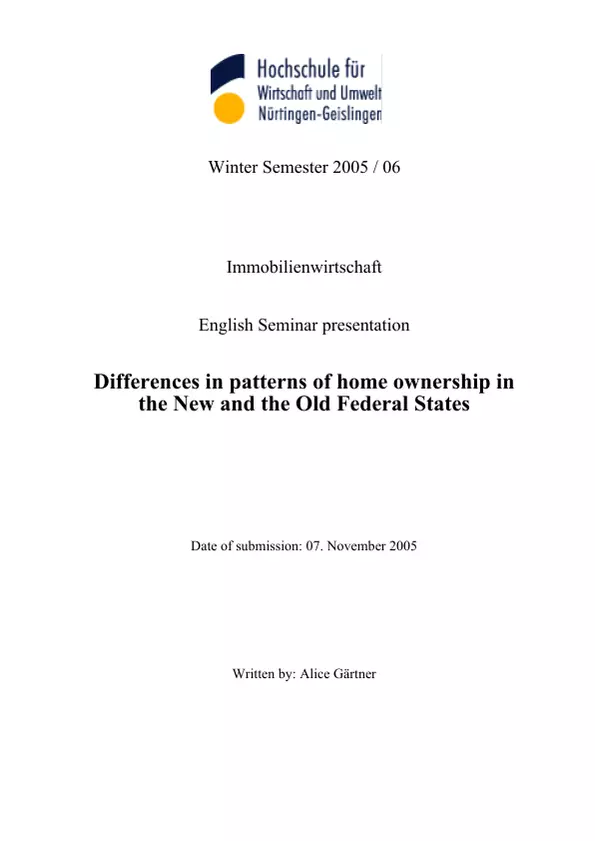This paper outlines the differences in patterns of home – ownership between the New and the Old Federal States in Germany. First the situation after the Second World War in 1945 and the development of the GDR and the FRG under occupation are shown. Afterwards the changes and problems in housing in the former GDR will be presented. Especially the privatization of flats in the New Federal states has also been worked out in detail. In order to have a better overview of the current owner occupied housing, statistical data are quoted.
Inhaltsverzeichnis (Table of Contents)
- List of Abbreviations
- Approach
- The situation after the Second World War
- The hour zero
- The division of Germany
- Different developments
- Housing politics in the GDR
- Housing politics in the FRG
- Changes after the reunification
- Steps to the reunification
- Problems during the transition to market economy
- Privatisation of residential property in the New Federal States
- Patterns in home ownership in 2002
- Conclusion
- References
Zielsetzung und Themenschwerpunkte (Objectives and Key Themes)
This paper examines the differences in home ownership patterns between the New and Old Federal States in Germany. The paper analyzes the post-World War II situation, the development of the GDR and FRG under occupation, and the impact of reunification on home ownership in the former GDR. It also examines the current situation of owner-occupied housing through statistical data.- The impact of the Second World War and subsequent division of Germany on housing patterns in the New and Old Federal States.
- The differences in housing policies and practices in the GDR and FRG during the Cold War.
- The challenges and changes experienced in housing ownership after German reunification in 1990.
- The privatization process and its influence on home ownership in the New Federal States.
- A statistical overview of the current situation of owner-occupied housing in Germany.
Zusammenfassung der Kapitel (Chapter Summaries)
- The "hour zero" following World War II saw widespread destruction and a severe housing shortage. The paper describes the difficult living conditions and the efforts to control immigration.1
- The division of Germany between the Soviet-occupied East and Western zones led to different economic and political systems, influencing housing policies and developments in the GDR and FRG.
- The chapter on housing politics in the GDR discusses the state-controlled system and its impact on housing availability and ownership.
- The chapter on housing politics in the FRG explores the development of the housing market and its characteristics in the Federal Republic of Germany.
- The chapter on changes after reunification examines the challenges and transformations faced in the former GDR, including the privatization of residential property and the transition to a market economy.
Schlüsselwörter (Keywords)
This paper focuses on the development of home ownership in Germany, specifically the differences between the New and Old Federal States. Key themes include post-war reconstruction, division of Germany, housing policies, privatization, and statistical analysis of owner-occupied housing.
Excerpt out of 47 pages
- scroll top
- Quote paper
- Dipl.-Betriebswirtin (FH) Alice Ebinger (Author), 2005, Differences in patterns of home ownership in the New and the Old Federal States, Munich, GRIN Verlag, https://www.grin.com/document/54245
Look inside the ebook



